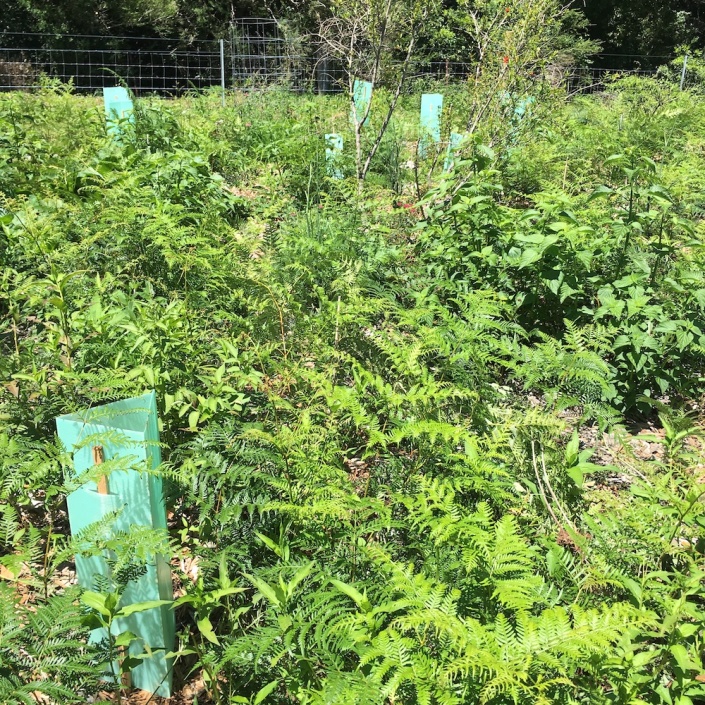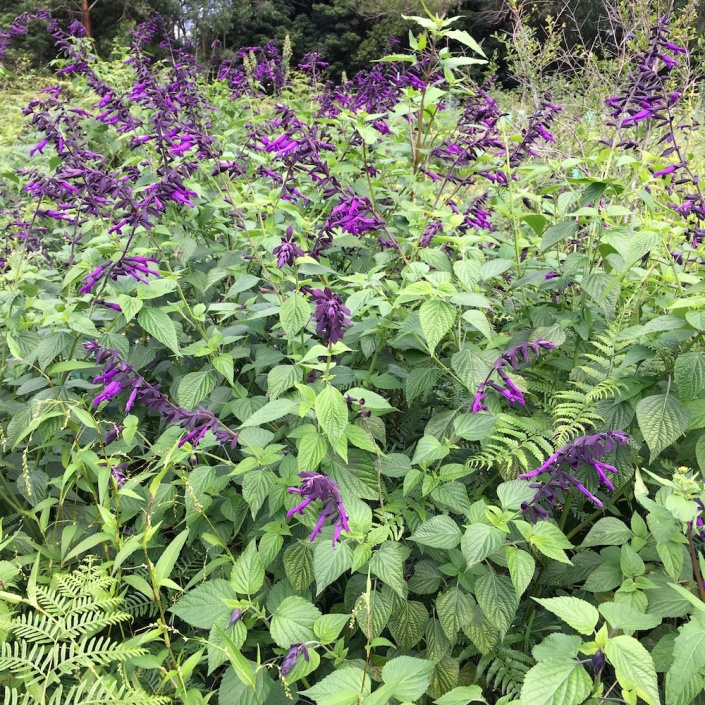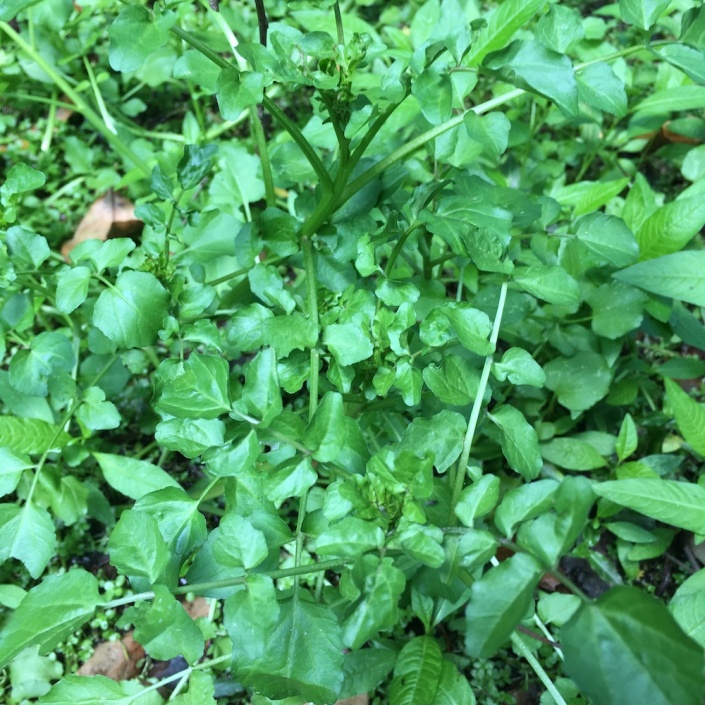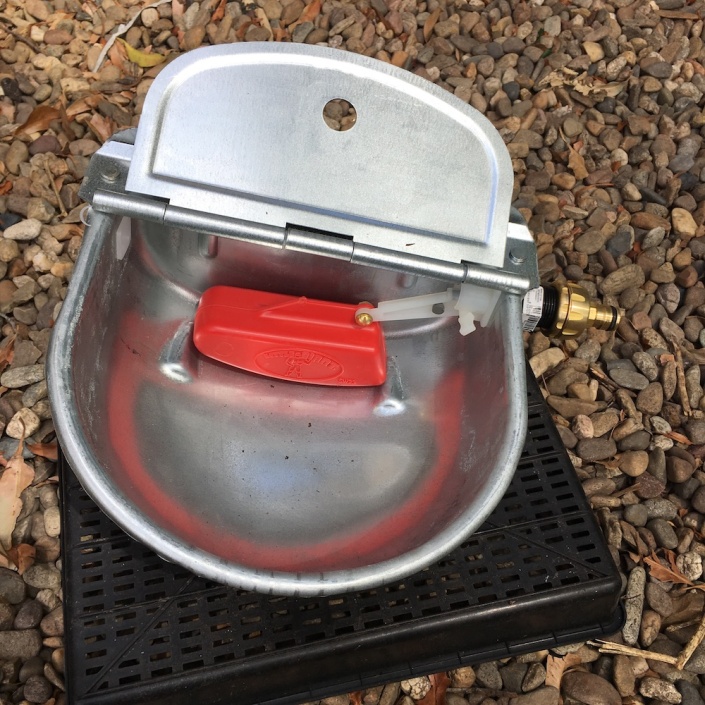Growing our own food
Our first citrus patch: going to plan, or to ruin?
I could hear my neighbours thinking, when I proudly showed off our first citrus patch:
“This is what he’s been blogging about?!? What a mess! He must be mad!”
I can understand why they think that. The mainstream advice for an orchard, described in the most recent Gardening Australia magazine, is: “space the trees widely enough apart that you can easily mow between them”.
This isn’t what we’ve done. Instead, we’ve been creating a citrus guild.
To recap: the goal is to plant around the citrus tree with a variety of beneficial plants, bringing nutrient up from the soil, attracting beneficial bugs, and controlling grass (the enemy of all fruiting trees).
This is was my sketch of what it would look like:

But seeing the reality, you can understand why our neighbours are having second thoughts:

The growth has been extraordinary, a testament to the quality of our soil, and the benefits of breaking up compaction from years of horses grazing. Still, it’s hard to even spot the dwarf citruses amongst everything else.
The rapid growth of the bracken ferns has been a surprise, but I think in a good way. Since these ferns are known to act as ‘dynamic accumulators’, bringing up nutrients from the soil, they seem like an ideal groundcover. The grass certainly doesn’t stand a chance against it.
The salvias have pushed through and are flowering profusely. The rue, yarrow and fennel are all flowering to the benefit of beneficial bugs. The comfrey is growing, but is struggling against the bracken ferns, so we’ll see how that goes.

The citrus trees all suffered heavy transplant shock, but I’m hopeful they’ll start to take off in earnest next season, pushing above the ferns. The pomegranate at the centre of the patch also hasn’t thrived, but we have just had the driest summer in 20 years, so I’m hopeful for next year.
Watch this space, and I’ll continue to report on the journey of our edible forest garden patches … to success, or ruin.
(I’ll also post some aerial photos and videos shortly, which will give another perspective on how it’s progressing.)
Discovering a hidden source of watercress
One of the great things about acquiring a 22 hectare (56 acre) farm is that there are still many hidden corners and surprises yet to discover.

One was the discovery of a small spring that feeds into the gully that runs beside the farmhouse. This has been running (slowly) even at the end of the recent very dry winter and spring, so that’s a good sign.

What we also stumbled across was a patch of watercress growing in the mini wetland at the top of the valley. The steady flow of water is exactly what it likes, and I can only guess that the previous owner must’ve planted some (?).

Anyway, it tastes delicious on a sandwich, and we have every reason to expect that it will keep happily growing indefinitely…
Helping city chickens with country technology
With our time now split between the city and our farm, it’s a bit harder to look after our flock of chicken. While our neighbours are happy to help out (in return for eggs!), the less that has to be done, the better.
Enter some tried-and-tested country technology: the automatic waterer.

This uses a ‘float valve’ to automatically cut the water when it reaches a specific height. When the animals drink from it and the levels drops, the water source cuts back in.
You won’t find this handy item at the local Bunnings; it is easy to find at a farm supply shop in the country. While it’s intended for horses, cattle, etc it works perfectly well for chickens.
This particular unit comes from the USA, and it has a 1/2″ connection for the water. With a bit of hunting in Bunnings I found a plastic adapter that went from 1/2″ to 3/4″, to which I could then add a standard hose fitting. Then it’s just click in the hose and you’re done.
One less thing to do in this busy life, plus happy chickens!
Second citrus patch planted

Following on from our first patch of dwarf citrus, a family work gang has helped us plant out our second patch. This is of full-sized citrus, with supporting guild.
A few notes:
- With full-sized rather than dwarf citrus, patch 2 is a little under twice the size of patch 1.
- The ‘spine’ of the planting are three Elaeagnus Ebbingei a nitrogen-fixing plant that increases the fertility of fruit trees, and is highly-recommended for permaculture gardens.
- There’s a mix of native citrus (eg finger lime), introduced citrus (eg navel orange) and a few that are hybrids of the two (eg sunrise lime).
- I’ve snuck a few berry bushes into the understory on the Eastern side (currants and gooseberry). I want to test how they perform in increasing shade, as well as seeing whether all the fruit is eaten by birds, etc. Consider it a living experiment 😉
- As before, everything is sheet mulched, with a bunch of ‘in-fill’ plants to go in shortly to shade out any weeds.
With Spring coming, lets see how this patch goes!
Pickling large cucumbers
Late in the season I planted two cucumber plants, with no great hopes for them. In Sydney’s hot and humid climate I’ve found that cucumbers, zucchinis, etc are killed off by powdery mildew long before they produce any real crop.
This time was different, and we were quickly overwhelmed by a glut of cucumbers, some of which had grown quite large.
Sandor Katz to the rescue! His book Wild fermentation — which really kick-started the recent fermentation movement — provided a useful recipe for sour pickles.
Undeterred by the fact I didn’t have lots of tiny “pickling cucumbers” I instead cut my big cukes into thin half-discs. The recipe suggested including grape or oak leaves to keep the pickles crisp, so I scavenged some oak leaves from the convent next door.

Into a big jar went the cucumbers, along with peppercorns, garlic cloves and dill flowers. I added an airlock, and left it to blip away for 3 weeks. And they behaved themselves perfectly: they didn’t bubble up and out the airlock, no mould grew on the surface, and the cucumber slices kept their shape.

We ate some slices today on a ham sandwich, and they are delightfully tart. Another win for Sandor, thanks!
Giving breathing room for two of our fruit trees
It always amazes me to see trees planted by themselves in a sea of grass.
Not only does the grass compete fearsomely with the trees, but the grass encourages a bacteria-dominated ecosystem in the soil rather than a fugal ecosystem, which trees require. Trees also prefer to live in a tightly-bound forest of their peers, where their roots are interconnected, making it possible for them to share resources.

No wonder then that the two lonely fruit trees planted at Lewisham Farm have been struggling. We think they might be peaches, but we won’t know until we’re able to get them to a point of being healthy enough to fruit!

The starting point is to cut away all the grass directly around the tree. We then sheet mulched with cardboard, and then weighed down with wombat poos (which we have many of, which is another story!).

(As a side note, there is a danger that the sheet mulching could stop water getting to the roots of the tree. In our case, the farm gets heaps of rain, the ground is well and truly moist.)
The trees will need much more help than this, and they’re also heading into winter dormancy. Still, it will hopefully give them some breathing room, while we find them a better home on the farm…
Constructing our first compost pile at the farm from pallets
If there’s one thing that gardening produces a lot of, it’s green waste that needs composting. So while we have a small compost bin for the farm’s kitchen scraps, a proper compost pile is needed for the garden, even at this early stage.

One of the easiest ways to create something fairly solid is to assemble a compost bay from pallets. What’s nice is that pallets are a free resource (the unbranded ones that is), which can be obtained (with permission!) from the loading bays of many shops.

The pallets are quite easy to screw together, to create a bay that’s two pallets wide, and two deep. Cover the inside of the pallets with shade cloth (or equivalent) to stop the compost falling out.
A half-size front makes it easier to add to the pile, and this is just wired on, allowing it to be easily removed when the compost needs turning (or harvesting!).

We’re only a few months into our farm adventure, and already we have a good-sized pile that should be ready by spring or summer. Happy days.
Our first harvest of dragon fruit
It’s been a while since we’ve done a “first of” post. We did many during the first heady months of establishing our first proper veg patch, when every harvest is new and exciting. After time, of course, it all becomes very routine and not worth mentioning.
Still, dragon fruit is a pretty spectacular thing! We were given a piece of this succulent by a friend, over five years ago. Since then it’s clambered up our fence and into the tree, but only now has it started to fruit.

The flowers are distinctive, and they bloom for only a very short period. A few weeks later, we had three bright red fruit standing out against the green of the plant, and the grey of the fence.

A possum eat one, but we still ended up with two fruit. We cut them up to use in a fruit salad, combined with a harvest of mangoes and some yoghurt, yum!

This is just one of the sub-tropical plants that I’m starting to grow in Sydney, as we seemingly shift inexorably away from a temperate climate.
Sweet potato as a source of greens

That mound of green is one of our current success stories in the garden, but not in the way we expected.
It’s sweet potato, and it’s the best example of my pivot from temperate to sub-tropical plants, matching the shift in Sydney’s climate. It isn’t eaten by slugs, snails, caterpillars or other bugs. It’s not affected by powdery mildew, rusts or other fungal diseases. It’s not even slightly stressed by 40deg heat.
Last season, however, it completely failed to provide edible tubers. Doh 😦
And then I saw on Gardening Australia that sweet potato leaves are edible. Eureka!
They’re treated like spinach leaves, steamed, fried or sautéed. They’re delicious, and we use them in salads, as a green alongside meat, or in stir-fries.
They’ve become all our all-year, all-weather source of greens. But let’s hope that this season they also give us actual sweet potatoes!
Drying our own (uncommon) herbs
Dried herbs are a pantry staple, used in everything from roasts to pasta sauces. While they’re easily obtainable in every supermarket, it’s nice to make your own.
Particularly when you’re drying herbs that simple can’t be found in shops.

Pineapple sage, apart from being loved by bees, makes a delicious tea. Infuse a teaspoon’s worth of herbs for 5mins, and then drink with delight.

Lemon-scented tea tree (leptospermum peteronii) has a lovely lemony taste, as the name would suggest. Distinctly different from a lemon, the dried herb can nonetheless be used as a replacement for lemon in soups, etc.

All of these herbs were dried in our cool cupboard, and the biggest effort is plucking off the leaves to store them.
What herbs are you drying from out of your garden?